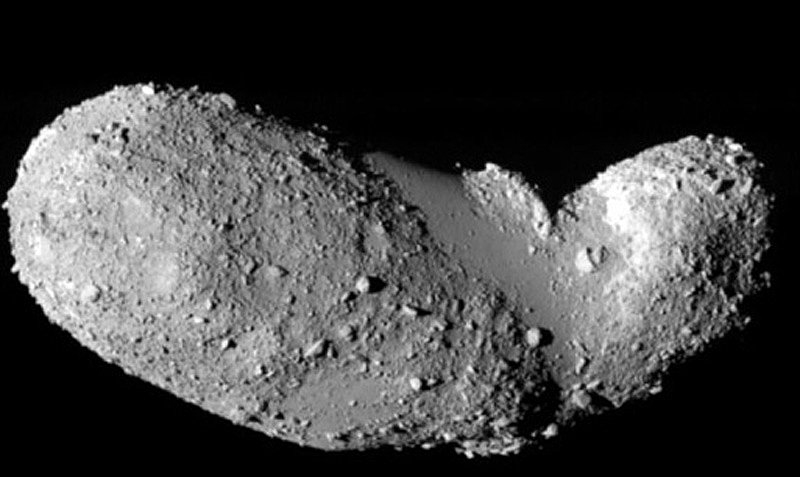Last week, scientists in MIT’s Department of Earth, Atmospheric and Planetary Sciences helped characterize three large, near-Earth asteroids, two of which measure about 12 miles in diameter — the largest asteroids to have been discovered in 23 years. The smallest of the three asteroids measures little more than a mile across, but it may pass within 3.4 million miles of Earth, making it a “potentially hazardous asteroid.”
The team made their measurements using NASA’s Infrared Telescope Facility in Hawaii as part of a project devoted to determining the compositions of new comets and asteroids relatively close to Earth. While these newest asteroids pose little danger to our planet in the near future, they possess some unusual features. MIT News spoke with Richard Binzel, a professor of planetary sciences, about his team’s measurements, and the likelihood of a close encounter.
Q: What are you able to tell about these three asteroids from your brief observations of them?
A: So far, we have made spectral color measurements of only the strangest one of these: 2013 UQ4. (These are names only scientists can love!) This object is coming from out beyond Pluto, from the region we call the Kuiper Belt. And to top it off, it is also orbiting in a backward direction compared to all the planets. Nearly all of the 1,000 currently known Kuiper Belt objects reside in orbits that at all times keep them at least as far away as Neptune. This new object, “UQ4,” is on an orbit that carries it closer to the sun than Mars, meaning that it comes rather close to the Earth. From our spectral measurements, we can estimate that its composition is likely carbon-rich, meaning the surface is very dark, reflecting only about 4 percent of the sunlight that hits it. Even though this object does not reflect very much light, the fact that we can see it in our telescopes implies that it must be rather large. From our measurements, we deduce it is nearly 20 kilometers, or 12 miles, across.
Q: The last large asteroid was detected 23 years ago. Why haven’t these new asteroids been detected until now? And what conditions made it possible for you to see them?
A: These newly found objects are in orbits that usually keep them rather far from the sun, meaning they are too faint to see. In addition to being far from the sun, they also spend most of their time way above or way below the plane where the Earth and other planets orbit — thus they are far from where astronomers concentrate most of their searches. So it has been a combination of these objects just happening to be getting close enough to the sun and the ongoing diligence of search teams that has revealed them to be there.
Q: What hazard, if any, do these near-Earth asteroids pose to our planet?
A: Fortunately, none of these objects poses any foreseeable hazard to Earth. Only one, 2013 UP8, approaches Earth’s orbit close enough to merit the categorization as “potentially hazardous.” All that means is that astronomers have a long-term interest to continue to track its orbit.
The team made their measurements using NASA’s Infrared Telescope Facility in Hawaii as part of a project devoted to determining the compositions of new comets and asteroids relatively close to Earth. While these newest asteroids pose little danger to our planet in the near future, they possess some unusual features. MIT News spoke with Richard Binzel, a professor of planetary sciences, about his team’s measurements, and the likelihood of a close encounter.
Q: What are you able to tell about these three asteroids from your brief observations of them?
A: So far, we have made spectral color measurements of only the strangest one of these: 2013 UQ4. (These are names only scientists can love!) This object is coming from out beyond Pluto, from the region we call the Kuiper Belt. And to top it off, it is also orbiting in a backward direction compared to all the planets. Nearly all of the 1,000 currently known Kuiper Belt objects reside in orbits that at all times keep them at least as far away as Neptune. This new object, “UQ4,” is on an orbit that carries it closer to the sun than Mars, meaning that it comes rather close to the Earth. From our spectral measurements, we can estimate that its composition is likely carbon-rich, meaning the surface is very dark, reflecting only about 4 percent of the sunlight that hits it. Even though this object does not reflect very much light, the fact that we can see it in our telescopes implies that it must be rather large. From our measurements, we deduce it is nearly 20 kilometers, or 12 miles, across.
Q: The last large asteroid was detected 23 years ago. Why haven’t these new asteroids been detected until now? And what conditions made it possible for you to see them?
A: These newly found objects are in orbits that usually keep them rather far from the sun, meaning they are too faint to see. In addition to being far from the sun, they also spend most of their time way above or way below the plane where the Earth and other planets orbit — thus they are far from where astronomers concentrate most of their searches. So it has been a combination of these objects just happening to be getting close enough to the sun and the ongoing diligence of search teams that has revealed them to be there.
Q: What hazard, if any, do these near-Earth asteroids pose to our planet?
A: Fortunately, none of these objects poses any foreseeable hazard to Earth. Only one, 2013 UP8, approaches Earth’s orbit close enough to merit the categorization as “potentially hazardous.” All that means is that astronomers have a long-term interest to continue to track its orbit.






